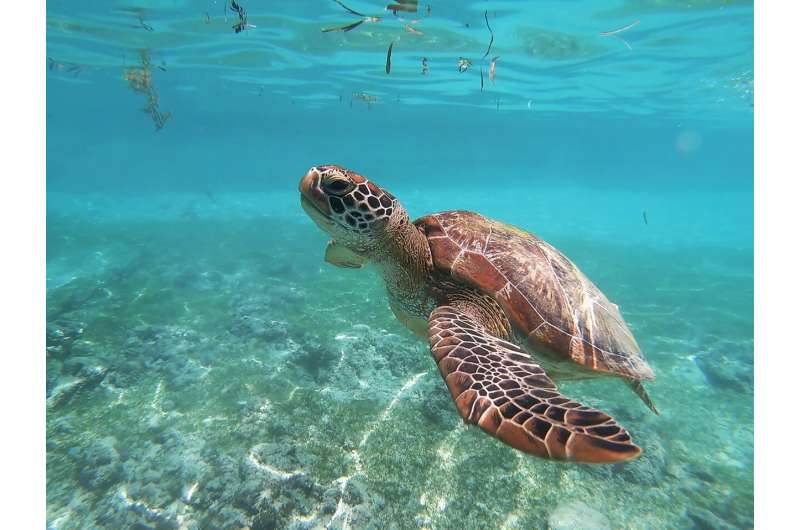Montserrat's wandering turtles highlight need for conservation without borders

Sea turtles that nest in Montserrat migrate and feed in the waters of multiple Caribbean countries and territories—according to a new study that highlights the need for international conservation efforts.
Researchers attached satellite tags to 10 nesting females (nine green turtles and a hawksbill) in Montserrat, to see where they went after laying their eggs. The turtles—which typically nest multiple times during a nesting season—traveled to a variety of places across the Caribbean.
Four green turtles headed for foraging grounds in Antigua and Barbuda, two to the US Virgin Islands, one to Puerto Rico, one to the Dominican Republic, and one remained in Montserrat's waters. The hawksbill turtle traveled to Guadeloupe.
The study was carried out by the University of Exeter, the Government of Montserrat and the Marine Conservation Society and is in Endangered Species Research.
"About 100 turtles—mostly greens and some hawksbills—nest each year from June to November in Montserrat," said Jack Wiggins, from the Center for Ecology and Conservation on Exeter's Penryn Campus in Cornwall.
"While these are modest numbers, these populations are regionally important at the Eastern Caribbean scale.
"Our findings can help with conservation planning in Montserrat—but also show that conservation has to be done cooperatively, across international borders."
The turtles in the study covered distances ranging from 45 km to 1,013 km, crossing 10 different national jurisdictions in total.
The study also highlights that protection for Montserrat's turtles is limited, with turtles spending just over 20% of their time in Marine Protected Areas (MPAs) during migration and foraging.
Dr. Nicola Weber, also from the University of Exeter, said, "Sea turtles currently have a varied level of protection across this region.
"They face a multitude of threats, including legal and illegal fishing, habitat destruction and the impacts of climate change.
"Our study highlights the importance of Montserrat for sea turtles, and helps to identify focal points for protection in a changing climate."
Working with researchers, Montserrat has recently created a Marine Turtle Action Plan to guide conservation efforts.
Daniel Edwards, Chief Fisheries and Ocean Governance Officer for the Government of Montserrat said, "The Government of Montserrat is proud to have contributed to this important research, which not only highlights the vital role of our island as a nesting site for green and hawksbill turtles but also underscores the shared responsibility of Caribbean nations in protecting these migratory species.
"This study provides essential data to inform our Marine Turtle Action Plan, as well as our broader efforts to implement sustainable marine conservation policies. We remain committed to safeguarding critical habitats, fostering regional collaboration, and addressing the challenges posed by climate change and human activities to ensure the survival of these species for future generations."
Amdeep Sanghera, UK Overseas Territories Conservation Officer at the Marine Conservation Society, added, "We are delighted to be part of this project, and having been able to support Montserratian community voices shape their Marine Turtle Action Plan. Through acknowledging local values, we can better safeguard Montserrat's regionally significant nesting turtle populations for future generations."
More information: J Wiggins et al, Satellite tracking reveals critical habitats and migratory pathways for green and hawksbill turtles nesting in Montserrat, Eastern Caribbean, Endangered Species Research (2024).
Journal information: Endangered Species Research
Provided by University of Exeter




















